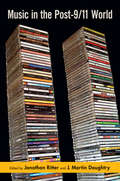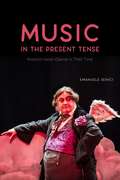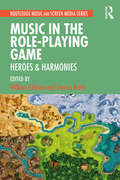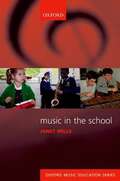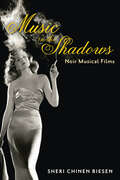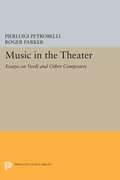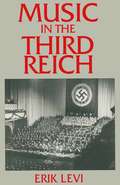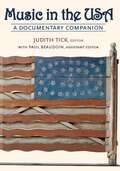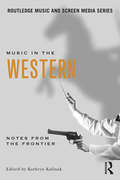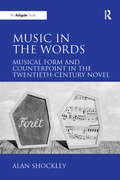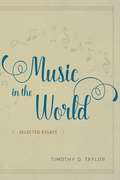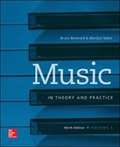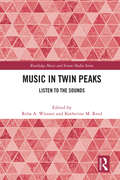- Table View
- List View
Music in the Post-9/11 World
by Jonathan Ritter J. Martin DaughtryMusic in the Post-9/11 World addresses the varied and complex roles music has played in the wake of September 11, 2001. Interdisciplinary in approach, international in scope, and critical in orientation, the twelve essays in this groundbreaking volume examine a diverse array of musical responses to the terrorist attacks of that day, and reflect upon the altered social, economic, and political environment of "post-9/11" music production and consumption. Individual essays are devoted to the mass-mediated works of popular musicians such as Bruce Springsteen and Darryl Worley, as well as to lesser-known musical responses by artists in countries including Afghanistan, Egypt, Mexico, Morocco, Peru, and Senegal. Contributors also discuss a range of themes including the role played by Western classical music in rites of mourning and commemoration, "invisible" musical practices such as the creation of television news music, and implicit censorship in the mainstream media. Taken as a whole, this collection presents powerful evidence of the central role music has played in expressing, shaping, and contesting worldwide public attitudes toward the defining event of the early twenty-first century.
Music in the Present Tense: Rossini’s Italian Operas in Their Time (Opera Lab: Explorations in History, Technology, and Performance)
by Emanuele SeniciIn the early 1800s, Rossini’s operas permeated Italy, from the opera house to myriad arrangements heard in public and private. But after Rossini stopped composing, a sharp decline in popularity drove most of his works out of the repertory. In the past half century, they have made a spectacular return to operatic stages worldwide, but this recent fame has not been accompanied by a comparable critical reevaluation. Emanuele Senici’s new book provides a fresh look at the motives behind the Rossinian furore and its aftermath by examining the composer’s works in the historical context in which they were conceived, performed, seen, heard, and discussed. Situating the operas firmly within the social practices, cultural formations, ideological currents, and political events of early nineteenth-century Italy, Senici reveals Rossini’s dramaturgy as a radically new and specifically Italian reaction to the epoch-making changes witnessed in Europe at the time. The first book-length study of Rossini’s Italian operas to appear in English, Music in the Present Tense exposes new ways to explore nineteenth-century music and addresses crucial issues in the history of modernity, such as trauma, repetition, and the healing power of theatricality.
Music in the Present Tense: Rossini’s Italian Operas in Their Time (Opera Lab: Explorations in History, Technology, and Performance)
by Emanuele SeniciIn the early 1800s, Rossini’s operas permeated Italy, from the opera house to myriad arrangements heard in public and private. But after Rossini stopped composing, a sharp decline in popularity drove most of his works out of the repertory. In the past half century, they have made a spectacular return to operatic stages worldwide, but this recent fame has not been accompanied by a comparable critical reevaluation. Emanuele Senici’s new book provides a fresh look at the motives behind the Rossinian furore and its aftermath by examining the composer’s works in the historical context in which they were conceived, performed, seen, heard, and discussed. Situating the operas firmly within the social practices, cultural formations, ideological currents, and political events of early nineteenth-century Italy, Senici reveals Rossini’s dramaturgy as a radically new and specifically Italian reaction to the epoch-making changes witnessed in Europe at the time. The first book-length study of Rossini’s Italian operas to appear in English, Music in the Present Tense exposes new ways to explore nineteenth-century music and addresses crucial issues in the history of modernity, such as trauma, repetition, and the healing power of theatricality.
Music in the Present Tense: Rossini’s Italian Operas in Their Time (Opera Lab: Explorations in History, Technology, and Performance)
by Emanuele SeniciIn the early 1800s, Rossini’s operas permeated Italy, from the opera house to myriad arrangements heard in public and private. But after Rossini stopped composing, a sharp decline in popularity drove most of his works out of the repertory. In the past half century, they have made a spectacular return to operatic stages worldwide, but this recent fame has not been accompanied by a comparable critical reevaluation. Emanuele Senici’s new book provides a fresh look at the motives behind the Rossinian furore and its aftermath by examining the composer’s works in the historical context in which they were conceived, performed, seen, heard, and discussed. Situating the operas firmly within the social practices, cultural formations, ideological currents, and political events of early nineteenth-century Italy, Senici reveals Rossini’s dramaturgy as a radically new and specifically Italian reaction to the epoch-making changes witnessed in Europe at the time. The first book-length study of Rossini’s Italian operas to appear in English, Music in the Present Tense exposes new ways to explore nineteenth-century music and addresses crucial issues in the history of modernity, such as trauma, repetition, and the healing power of theatricality.
Music in the Present Tense: Rossini’s Italian Operas in Their Time (Opera Lab: Explorations in History, Technology, and Performance)
by Emanuele SeniciIn the early 1800s, Rossini’s operas permeated Italy, from the opera house to myriad arrangements heard in public and private. But after Rossini stopped composing, a sharp decline in popularity drove most of his works out of the repertory. In the past half century, they have made a spectacular return to operatic stages worldwide, but this recent fame has not been accompanied by a comparable critical reevaluation. Emanuele Senici’s new book provides a fresh look at the motives behind the Rossinian furore and its aftermath by examining the composer’s works in the historical context in which they were conceived, performed, seen, heard, and discussed. Situating the operas firmly within the social practices, cultural formations, ideological currents, and political events of early nineteenth-century Italy, Senici reveals Rossini’s dramaturgy as a radically new and specifically Italian reaction to the epoch-making changes witnessed in Europe at the time. The first book-length study of Rossini’s Italian operas to appear in English, Music in the Present Tense exposes new ways to explore nineteenth-century music and addresses crucial issues in the history of modernity, such as trauma, repetition, and the healing power of theatricality.
Music in the Role-Playing Game: Heroes & Harmonies
by William Gibbons Steven RealeMusic in the Role-Playing Game: Heroes & Harmonies offers the first scholarly approach focusing on music in the broad class of video games known as role-playing games, or RPGs. Known for their narrative sophistication and long playtimes, RPGs have long been celebrated by players for the quality of their cinematic musical scores, which have taken on a life of their own, drawing large audiences to live orchestral performances. The chapters in this volume address the role of music in popular RPGs such as Final Fantasy and World of Warcraft, delving into how music interacts with the gaming environment to shape players’ perceptions and engagement. The contributors apply a range of methodologies to the study of music in this genre, exploring topics such as genre conventions around music, differences between music in Japanese and Western role-playing games, cultural representation, nostalgia, and how music can shape deeply personal game experiences. Music in the Role-Playing Game expands the growing field of studies of music in video games, detailing the considerable role that music plays in this modern storytelling medium, and breaking new ground in considering the role of genre. Combining deep analysis with accessible personal accounts of authors’ experiences as players, it will be of interest to students and scholars of music, gaming, and media studies.
Music in the Role-Playing Game: Heroes & Harmonies
by William Gibbons Steven RealeMusic in the Role-Playing Game: Heroes & Harmonies offers the first scholarly approach focusing on music in the broad class of video games known as role-playing games, or RPGs. Known for their narrative sophistication and long playtimes, RPGs have long been celebrated by players for the quality of their cinematic musical scores, which have taken on a life of their own, drawing large audiences to live orchestral performances. The chapters in this volume address the role of music in popular RPGs such as Final Fantasy and World of Warcraft, delving into how music interacts with the gaming environment to shape players’ perceptions and engagement. The contributors apply a range of methodologies to the study of music in this genre, exploring topics such as genre conventions around music, differences between music in Japanese and Western role-playing games, cultural representation, nostalgia, and how music can shape deeply personal game experiences. Music in the Role-Playing Game expands the growing field of studies of music in video games, detailing the considerable role that music plays in this modern storytelling medium, and breaking new ground in considering the role of genre. Combining deep analysis with accessible personal accounts of authors’ experiences as players, it will be of interest to students and scholars of music, gaming, and media studies.
Music in the School: (pdf)
by Janet MillsHow do some schools get music so right while others get it so wrong? Janet Mills, a former HMI and teacher, draws on work in more than 800 schools and published research as she seeks to help schools improve their practice - no matter how good it is already. Successful teaching, she argues, is creative, uplifting, enabling, and, above all, rooted in music. The aim of this book is to 'Put the music back into music'.Thought-provoking, challenging, and empowering, this book is an essential read for all those interested in music in schools, including class teachers, instrumental teachers, and researchers. Using informative and entertaining examples and anecdotes, Janet Mills criticizes notions such as 'musical children' and 'musical schools', and comments on the roles of instrumental teachers and so-called 'non-specialists'. She explores how music in school can, and must, interact with music out of school, and considers how to measure progress in music - and how not to. Music in the School is not a step-by-step guide to better teaching, but rather a springboard for consideration, reflection, and action. Anyone who cares about music at school will find this book a powerful tool.
Music in the Shadows: Noir Musical Films
by Sheri Chinen BiesenSmoke. Shadows. Moody strains of jazz. Welcome to the world of "noir musical" films, where tormented antiheroes and hard-boiled musicians battle obsession and struggle with their music and ill-fated love triangles. Sultry divas dance and sing the blues in shrouded nightclubs. Romantic intrigue clashes with backstage careers. In her pioneering study, Music in the Shadows, film noir expert Sheri Chinen Biesen explores musical films that use film noir style and bluesy strains of jazz to inhabit a disturbing underworld and reveal the dark side of fame and the American Dream. While noir musical films like A Star Is Born include musical performances, their bleak tone and expressionistic aesthetic more closely resemble the visual style of film noir. Their narratives unfold behind a stark noir lens: distorted, erratic angles and imbalanced hand-held shots allow the audience to experience a tortured, disillusioned perspective.While many musicals glamorize the quest for the spotlight in Hollywood's star factory, brooding noir musical films such as Blues in the Night, Gilda, The Red Shoes, West Side Story, and Round Midnight stretch the boundaries of film noir and the musical as film genres collide. Deep shadows, dim lighting, and visual composition evoke moodiness, cynicism, pessimism, and subjective psychological points of view.As in her earlier study of film noir, Blackout: World War II and the Origins of Film Noir, Biesen draws on extensive primary research in studio archives to situate her examination within a historical, industrial, and cultural context.
Music in the Shadows: Noir Musical Films
by Sheri Chinen BiesenSmoke. Shadows. Moody strains of jazz. Welcome to the world of "noir musical" films, where tormented antiheroes and hard-boiled musicians battle obsession and struggle with their music and ill-fated love triangles. Sultry divas dance and sing the blues in shrouded nightclubs. Romantic intrigue clashes with backstage careers. In her pioneering study, Music in the Shadows, film noir expert Sheri Chinen Biesen explores musical films that use film noir style and bluesy strains of jazz to inhabit a disturbing underworld and reveal the dark side of fame and the American Dream. While noir musical films like A Star Is Born include musical performances, their bleak tone and expressionistic aesthetic more closely resemble the visual style of film noir. Their narratives unfold behind a stark noir lens: distorted, erratic angles and imbalanced hand-held shots allow the audience to experience a tortured, disillusioned perspective.While many musicals glamorize the quest for the spotlight in Hollywood's star factory, brooding noir musical films such as Blues in the Night, Gilda, The Red Shoes, West Side Story, and Round Midnight stretch the boundaries of film noir and the musical as film genres collide. Deep shadows, dim lighting, and visual composition evoke moodiness, cynicism, pessimism, and subjective psychological points of view.As in her earlier study of film noir, Blackout: World War II and the Origins of Film Noir, Biesen draws on extensive primary research in studio archives to situate her examination within a historical, industrial, and cultural context.
Music in the Theater: Essays on Verdi and Other Composers
by Pierluigi Petrobelli Roger ParkerWell-known for leading audiences to a new appreciation of Verdi as a subtle and elaborate musical thinker, Pierluigi Petrobelli here turns his attention to the intriguing question of how musical theater works. In this collection of lively, penetrating essays, Petrobelli analyzes specific operas, mainly by Verdi, in terms of historical context, musical organization, and dramaturgical conventions.Originally published in 1994.The Princeton Legacy Library uses the latest print-on-demand technology to again make available previously out-of-print books from the distinguished backlist of Princeton University Press. These editions preserve the original texts of these important books while presenting them in durable paperback and hardcover editions. The goal of the Princeton Legacy Library is to vastly increase access to the rich scholarly heritage found in the thousands of books published by Princeton University Press since its founding in 1905.
Music in the Third Reich
by Erik LeviIn this authoritative study, one of the first to appear in English, Erik Levi explores the ambiguous relationship between music and politics during one of the darkest periods of recent cultural history. Utilising material drawn from contemporary documents, journals and newspapers, he traces the evolution of reactionary musical attitudes which were exploited by the Nazis in the final years of the Weimar Republic, chronicles the mechanisms that were established after 1933 to regiment musical life throughout Germany and the occupied territories, and examines the degree to which the climate of xenophobia, racism and anti-modernism affected the dissemination of music either in the opera house and concert hall, or on the radio and in the media.
Music in the USA: A Documentary Companion
by Judith Tick Paul BeaudoinMusic in the USA: A Documentary Companion charts a path through American music and musical life using as guides the words of composers, performers, writers and the rest of us ordinary folks who sing, dance, and listen. The anthology of primary sources contains about 160 selections from 1540 to 2000. Sometimes the sources are classics in the literature around American music, for example, the Preface to the Bay Psalm Book, excerpts from Slave Songs of the United States, and Charles Ives extolling Emerson. But many other selections offer uncommon sources, including a satirical story about a Yankee music teacher; various columns from 19th-century German American newspapers; the memoirs of a 19th-century diva; Lottie Joplin remembering her husband Scott; a little-known reflection of Copland about Stravinsky; an interview with Muddy Waters from the Chicago Defender; a letter from Woody Guthrie on the "spunkfire" attitude of a folk song; a press release from the Country Music Association; and the Congressional testimony around "Napster." "Sidebar" entries occasionally bring a topic or an idea into the present, acknowledging the extent to which revivals of many kinds of music play a role in American contemporary culture. This book focuses on the connections between theory and practice to enrich our understanding of the diversity of American musical experiences. Designed especially to accompany college courses which survey American music as a whole, the book is also relevant to courses in American history and American Studies.
Music in the Western: Notes From the Frontier
by Kathryn KalinakMusic in the Western: Notes from the Frontier presents essays from both film studies scholars and musicologists on core issues in western film scores: their history, their generic conventions, their operation as part of a narrative system, their functioning within individual filmic texts and their ideological import, especially in terms of the western’s construction of gender, sexuality, race and ethnicity. The Hollywood western is marked as uniquely American by its geographic setting, prototypical male protagonist and core American values. Music in the Western examines these conventions and the scores that have shaped them. But the western also had a resounding international impact, from Europe to Asia, and this volume distinguishes itself by its careful consideration of music in non-Hollywood westerns, such as Ravenous and The Good, the Bad, and the Ugly and in the “easterns” which influenced them, such as Yojimbo. Other films discussed include Wagon Master, High Noon, Calamity Jane, The Big Country, The Unforgiven, Dead Man, Wild Bill, There Will Be Blood and No Country for Old Men. Contributors Ross CareCorey K. CreekmurYuna de LannoyK. J. DonnellyCaryl FlinnClaudia GorbmanKathryn KalinakCharles LeinbergerMatthew McDonaldPeter StanfieldMariana WhitmerBen Winters The Routledge Music and Screen Media Series offers edited collections of original essays on music in particular genres of cinema, television, video games and new media. These edited essay collections are written for an interdisciplinary audience of students and scholars of music and film and media studies.
Music in the Western: Notes From the Frontier
by Kathryn KalinakMusic in the Western: Notes from the Frontier presents essays from both film studies scholars and musicologists on core issues in western film scores: their history, their generic conventions, their operation as part of a narrative system, their functioning within individual filmic texts and their ideological import, especially in terms of the western’s construction of gender, sexuality, race and ethnicity. The Hollywood western is marked as uniquely American by its geographic setting, prototypical male protagonist and core American values. Music in the Western examines these conventions and the scores that have shaped them. But the western also had a resounding international impact, from Europe to Asia, and this volume distinguishes itself by its careful consideration of music in non-Hollywood westerns, such as Ravenous and The Good, the Bad, and the Ugly and in the “easterns” which influenced them, such as Yojimbo. Other films discussed include Wagon Master, High Noon, Calamity Jane, The Big Country, The Unforgiven, Dead Man, Wild Bill, There Will Be Blood and No Country for Old Men. Contributors Ross CareCorey K. CreekmurYuna de LannoyK. J. DonnellyCaryl FlinnClaudia GorbmanKathryn KalinakCharles LeinbergerMatthew McDonaldPeter StanfieldMariana WhitmerBen Winters The Routledge Music and Screen Media Series offers edited collections of original essays on music in particular genres of cinema, television, video games and new media. These edited essay collections are written for an interdisciplinary audience of students and scholars of music and film and media studies.
Music in the Words: Musical Form and Counterpoint in the Twentieth-Century Novel
by Alan ShockleyThere is a strong tradition of literary analyses of the musical artwork. Simply put, all musicology - any writing about music - is an attempt at making analogies between what happens within the world of sound and language itself. This study considers this analogy from the opposite perspective: authors attempting to structure words using musical forms and techniques. It's a viewpoint much more rarely explored, and none of the extant studies of novelists' musical techniques have been done by musicians. Can a novel follow the form of a symphony and still succeed as a novel? Can musical counterpoint be mimicked by words on a page? Alan Shockley begins looking for answers by examining music's appeal for novelists, and then explores two brief works, a prose fugue by Douglas Hofstadter, and a short story by Anthony Burgess modeled after a Mozart symphony. Analyses of three large, emblematic attempts at musical writing follow. The much debated 'Sirens' episode of James Joyce's Ulysses, which the author famously likened to a fugue, Burgess' largely ignored Napoleon Symphony: A Novel in Four Movements, patterned on Beethoven's Eroica, and Joyce's Finnegans Wake, which Shockley examines as an attempt at composing a fully musicalized language. After these three larger analyses, Shockley discusses two quite recent brief novels, William Gaddis' novella Agap gape and David Markson's This is not a novel, proposing that each of these confounding texts coheres elegantly when viewed as a musically-structured work. From the perspective of a composer, Shockley offers the reader fresh tools for approaching these dense and often daunting texts.
Music in the Words: Musical Form and Counterpoint in the Twentieth-Century Novel
by Alan ShockleyThere is a strong tradition of literary analyses of the musical artwork. Simply put, all musicology - any writing about music - is an attempt at making analogies between what happens within the world of sound and language itself. This study considers this analogy from the opposite perspective: authors attempting to structure words using musical forms and techniques. It's a viewpoint much more rarely explored, and none of the extant studies of novelists' musical techniques have been done by musicians. Can a novel follow the form of a symphony and still succeed as a novel? Can musical counterpoint be mimicked by words on a page? Alan Shockley begins looking for answers by examining music's appeal for novelists, and then explores two brief works, a prose fugue by Douglas Hofstadter, and a short story by Anthony Burgess modeled after a Mozart symphony. Analyses of three large, emblematic attempts at musical writing follow. The much debated 'Sirens' episode of James Joyce's Ulysses, which the author famously likened to a fugue, Burgess' largely ignored Napoleon Symphony: A Novel in Four Movements, patterned on Beethoven's Eroica, and Joyce's Finnegans Wake, which Shockley examines as an attempt at composing a fully musicalized language. After these three larger analyses, Shockley discusses two quite recent brief novels, William Gaddis' novella Agap gape and David Markson's This is not a novel, proposing that each of these confounding texts coheres elegantly when viewed as a musically-structured work. From the perspective of a composer, Shockley offers the reader fresh tools for approaching these dense and often daunting texts.
Music in the World: Selected Essays
by Timothy D. TaylorIn music studies, Timothy D. Taylor is known for his insightful essays on music, globalization, and capitalism. Music in the World is a collection of some of Taylor’s most recent writings—essays concerned with questions about music in capitalist cultures, covering a historical span that begins in the late nineteenth and early twentieth centuries and continues to the present. These essays look at shifts in the production, dissemination, advertising, and consumption of music from the industrial capitalism of the nineteenth century to the globalized neoliberal capitalism of the past few decades. In addition to chapters on music, capitalism, and globalization, Music in the World includes previously unpublished essays on the continuing utility of the concept of culture in the study of music, a historicization of treatments of affect, and an essay on value and music. Taken together, Taylor’s essays chart the changes in different kinds of music in twentieth- and twenty-first-century music and culture from a variety of theoretical perspectives.
Music in the World: Selected Essays
by Timothy D. TaylorIn music studies, Timothy D. Taylor is known for his insightful essays on music, globalization, and capitalism. Music in the World is a collection of some of Taylor’s most recent writings—essays concerned with questions about music in capitalist cultures, covering a historical span that begins in the late nineteenth and early twentieth centuries and continues to the present. These essays look at shifts in the production, dissemination, advertising, and consumption of music from the industrial capitalism of the nineteenth century to the globalized neoliberal capitalism of the past few decades. In addition to chapters on music, capitalism, and globalization, Music in the World includes previously unpublished essays on the continuing utility of the concept of culture in the study of music, a historicization of treatments of affect, and an essay on value and music. Taken together, Taylor’s essays chart the changes in different kinds of music in twentieth- and twenty-first-century music and culture from a variety of theoretical perspectives.
Music in the World: Selected Essays
by Timothy D. TaylorIn music studies, Timothy D. Taylor is known for his insightful essays on music, globalization, and capitalism. Music in the World is a collection of some of Taylor’s most recent writings—essays concerned with questions about music in capitalist cultures, covering a historical span that begins in the late nineteenth and early twentieth centuries and continues to the present. These essays look at shifts in the production, dissemination, advertising, and consumption of music from the industrial capitalism of the nineteenth century to the globalized neoliberal capitalism of the past few decades. In addition to chapters on music, capitalism, and globalization, Music in the World includes previously unpublished essays on the continuing utility of the concept of culture in the study of music, a historicization of treatments of affect, and an essay on value and music. Taken together, Taylor’s essays chart the changes in different kinds of music in twentieth- and twenty-first-century music and culture from a variety of theoretical perspectives.
Music in the World: Selected Essays
by Timothy D. TaylorIn music studies, Timothy D. Taylor is known for his insightful essays on music, globalization, and capitalism. Music in the World is a collection of some of Taylor’s most recent writings—essays concerned with questions about music in capitalist cultures, covering a historical span that begins in the late nineteenth and early twentieth centuries and continues to the present. These essays look at shifts in the production, dissemination, advertising, and consumption of music from the industrial capitalism of the nineteenth century to the globalized neoliberal capitalism of the past few decades. In addition to chapters on music, capitalism, and globalization, Music in the World includes previously unpublished essays on the continuing utility of the concept of culture in the study of music, a historicization of treatments of affect, and an essay on value and music. Taken together, Taylor’s essays chart the changes in different kinds of music in twentieth- and twenty-first-century music and culture from a variety of theoretical perspectives.
Music in the World: Selected Essays
by Timothy D. TaylorIn music studies, Timothy D. Taylor is known for his insightful essays on music, globalization, and capitalism. Music in the World is a collection of some of Taylor’s most recent writings—essays concerned with questions about music in capitalist cultures, covering a historical span that begins in the late nineteenth and early twentieth centuries and continues to the present. These essays look at shifts in the production, dissemination, advertising, and consumption of music from the industrial capitalism of the nineteenth century to the globalized neoliberal capitalism of the past few decades. In addition to chapters on music, capitalism, and globalization, Music in the World includes previously unpublished essays on the continuing utility of the concept of culture in the study of music, a historicization of treatments of affect, and an essay on value and music. Taken together, Taylor’s essays chart the changes in different kinds of music in twentieth- and twenty-first-century music and culture from a variety of theoretical perspectives.
Music in the World: Selected Essays
by Timothy D. TaylorIn music studies, Timothy D. Taylor is known for his insightful essays on music, globalization, and capitalism. Music in the World is a collection of some of Taylor’s most recent writings—essays concerned with questions about music in capitalist cultures, covering a historical span that begins in the late nineteenth and early twentieth centuries and continues to the present. These essays look at shifts in the production, dissemination, advertising, and consumption of music from the industrial capitalism of the nineteenth century to the globalized neoliberal capitalism of the past few decades. In addition to chapters on music, capitalism, and globalization, Music in the World includes previously unpublished essays on the continuing utility of the concept of culture in the study of music, a historicization of treatments of affect, and an essay on value and music. Taken together, Taylor’s essays chart the changes in different kinds of music in twentieth- and twenty-first-century music and culture from a variety of theoretical perspectives.
Music In Theory And Practice Volume 1 (PDF)
by Bruce Benward Marilyn SakerThis best-selling text gives music majors and minors a solid foundation in the theory of music. It strengthens their musical intuition, builds technical skills, and helps them gain interpretive insights. The goal of the text is to instruct readers on the practical application of knowledge. The analytical techniques presented are carefully designed to be clear, uncomplicated, and readily applicable to any repertoire. The two-volume format ensures exhaustive coverage and maximum support for students and faculty alike. Volume I serves as a general introduction to music theory while Volume II offers a survey of the theoretical underpinnings of musical styles and forms from Gregorian Chant through the present day. The supplemental instructor's materials provide clear-cut solutions to assignment materials. Music in Theory and Practice is a well-rounded textbook that integrates the various components of musical structure and makes them accessible to students at the undergraduate level.
Music in Twin Peaks: Listen to the Sounds
by Katherine M. ReedIn this edited volume, contributors explore an essential element of the influential television series Twin Peaks: the role of music and sound. From its debut in 1990 to its return to television in 2017, Twin Peaks has amassed a cult following, and inspired myriad scholarly studies. This collection considers how the music and sound design not only create the ambience of this ground-breaking series, but function in the narrative, encouraging multiple interpretations. With chapters that consider how music shapes the relationship of audiences and fans to the story, the importance of sound design, and the symbolism embedded in the score, this book provides a range of perspectives for scholars of music and film studies, while giving fans new insight into an iconic television show.
